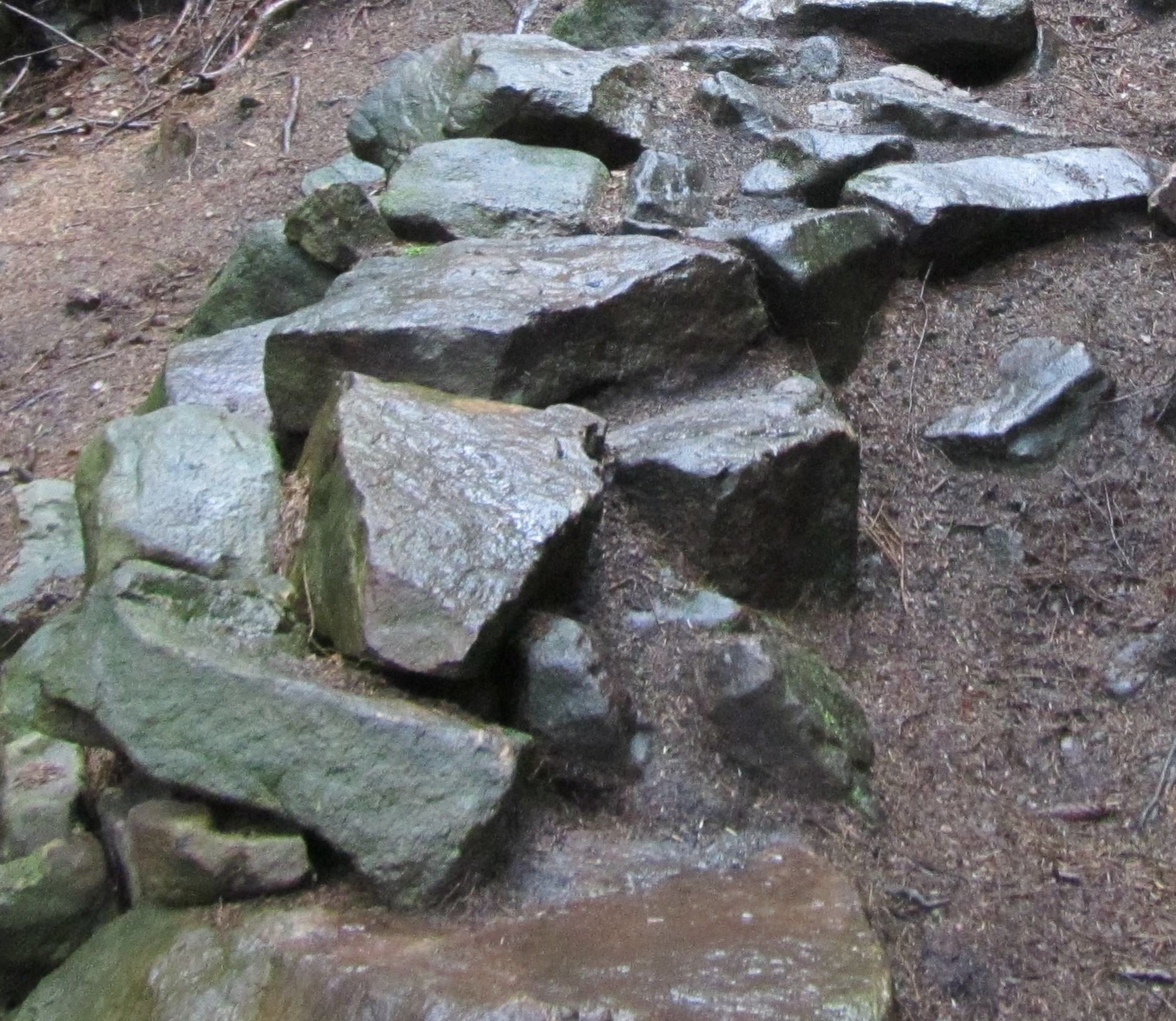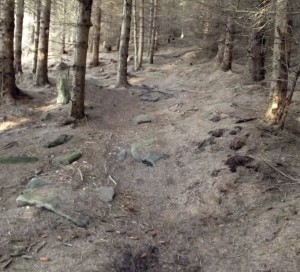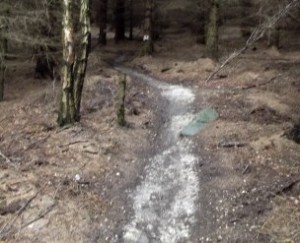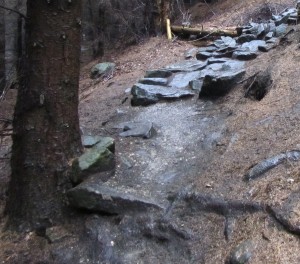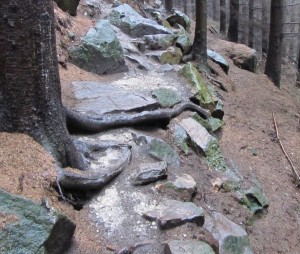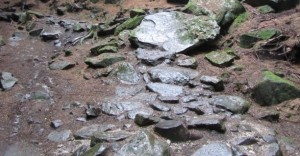Warren Boulder Trail has a reputation. It is a reputation forged in blood, bruises and brown trousers. It is a reputation for Rocks. But sitting as it does in the thick Stainburn Forest this 2004 trail has been slowly but surely reclaimed by nature. The lines have slowly changed and migrated, the aggregate surface lost under years of pine needles.
Well not any more.
Having never known the Warren Boulder Trail any other way I often suspected I was riding in the wrong place; either along side the line of rocks that in actual fact were the trail, or the wrong side of the trail edging. My sheep like brain just following the most ridden trail only to realise that the most ridden trail was not trail at all.
At times like this I would think how good it would be if someone would redefine the line, highlight in some way the rocks that are supposed to be ridden over not around and generally do whatever needed to be done in order to give the sheep-like the required inputs to see, prepare for, and who knows maybe even successfully ride the trail as it was meant to be, as it was designed by the original trail builders who somehow carved a trail into this steep, dense, boulder strewn hillside.
Don’t get me wrong, it was still a challenging, nerve-racking and thrilling trail to ride, giving a mixture of pride and relief when you finally rolled out of the bottom. But this was undermined by the lack of a clear line, unofficial chicken runs that were more dominant than the main line, and sections of trail many feet away from where they should be, the ride faltered by the uncertainty and indecision of constantly asking “Where am I supposed to ride?”.
There was another reason I wanted to be involved when Knacker (Stainburn Head of Trails) suggested some evening sessions to redefine the trail, a similar reason to why I first came to a trailbuilding day at Stainburn a couple of years ago. Trail work and maintenance is a fantastic way to get a really good look at and demystify a trail. When riding a trail you only glance quickly at each part, enough to choose your line, then by the time you’re riding that line, you’re looking further ahead and then you are gone.
You never really (unless you stop/fail/plant) look in detail at the features you ride and I wanted to detailed look at the WBT, a trail which if I put off riding it for a few months would often begin to lurk intimidatingly in the dark beyond the car park, growing in menace every time I decided to give it a miss – it’s reputation supplanting the simple fact that I can actually ride most of it.
So after successful trial, Knacker set a date and we all showed up. The original, simple plan (and like others that have come before it, quite optimistic) was to spend one or two evenings walking the trail, lightly brushing aside the accumulated dust, twigs and pine needles and be done.
The plan failed.
In the eight years since the first bits of trail were put in, needles and other bits of organic material that covered the trail have decomposed and rotted to become thick, dense and from a gardening point of view, absolutely cracking looking soil. Seriously, I could grow some amazing onions/potatoes/beans in the stuff we were scraping from the trail. But I wasn’t about to start trying to get it back up the hill and home though, so instead, reluctantly I flung it down the hillside beneath us.
In the end it took six weeks, often with a couple of sessions a week, over 100 man hours in total.
While the rock sections just had deposits between their teeth, the flat sections often had layers many inches deep. So deep that at times wondered if we would even find the trail bed as we cut it away in slabs it was so compact. This was fast turning more into Trail Archaeology. The volunteers quickly found themselves using a fair selection of the STA range of tools.
- Rakes: for loosening up material which had become compacted over the years, or shifting loose pine needles that would soon fall onto the trail.
- Brushes: for clearing loosened material, removal of loose needles or for that final touch (Wannabrew can put a fine polish on a newly reclaimed rock section with a good broom and a can of Mr Sheen!).
- Grubbing tool (choose your favourite): for scrapping or cutting away the soil when its too deep and too serious for either of the above.
Combining them in various orders until the scritching-grating sound of metal on stone was finally heard.
Often we found the line had become a vague slightly lazy version of it’s original self, many people were just riding off the trail, for sections of 10 yards or more. Out of nerves, or out of confusion – it was becoming hard to say.
By contrast, on the wooded climb known as Weird Wood we were often probing the ground to see which way the trail bed actually went (yes there is trail bed in there!), the varied lines had come from people trying to just get up the hill any way they could find. Once the original line has been lost it was understandable, riders were looking for roots and rocks to put under their tyre and get some traction, the climb was enjoyable, but also a maze of multiple choice.
On one occasion we found ourselves digging deeper and deeper and still no finding trail bed. The section we were digging was in a dip so it wasn’t unthinkable that it had become deeply buried. Like an episode of Time Team we dug two exploratory trenches in the hope of revealing that wonderful pale aggregate surface but in both cases we were disappointed.
Nothing.
Just a mess of roots.
We tried to convince our selves that the trail had become lost and washed away. But we weren’t buying it. Lib, Club Treasurer and general responsible adult suggested it might actually follow a different line altogether. But this line looked so unridden, untouched and indistinguishable from the rest of the forest floor that we dismissed the idea.
We sat down for a rest and refreshment, but eventually all found ourselves looking at this same place. The line Lib had suggested. We decided to get full-on Time Team, and do some Geo-Phys. Though where their Geo-Phys involves using radio waves along a carefully laid out grid pattern and lengthy analysis, ours is basically swinging a pick into the ground to see sound it makes.
We swung, and it turned out Lib was right. That reliable chink of metal on trail bed came back on each gentle, probing swing. As we pulled at the edges the inch deep carpet of forest floor peeled back in one satisfying piece to reveal almost virgin trail underneath. It must have disappeared very soon after being put in place, not only was it in fantastic condition but non of the STA elders remembered it being there in the first place. We cut the covering layer at the trail edges and looked at what we had found. Then we looked at the old line, which now seemed very obviously to be in a silly place that could only collect debris and mud.
Other discoveries came as less of a revelation. The trail between Hovis corner and the Cascade seemed flat and smooth when we started work on it, a small respite to allow the rider to regain their composure before the intimidating rock line which seems to eject so many riders before it’s actual end (yours truly included). But once more as we cut away the compacted build-up we found that time had buried the true trail and sanitised it. It was not only a foot to the left, but far from smooth.
In and amongst correcting trail creep and uncovering long lost rock sections, blocking the cheeky go-arounds and giving a few helping hints to the rider to make the line clearer – I have had the chance to get to know Warren Boulder a little better. The hour I spent stood below the Steps of Terror, brushing and scraping them to bring back the stone (and the Terror) left me convinced I would never ride again them but skid to a halt the next time I encountered them. They seemed insanely threatening and the exit worryingly narrow. But there was no need to worry, when the time came I rolled right past them without noticing.
So what have we achieved in these six weeks?
While performing the work we would joke we were making it scarier, giving the trail back it’s teeth. Having ridden it, it seems the opposite is true. In making the trail bed and rock surfaces clearly visible we’ve made it less of an unknown, we’ve made it easier for riders to assess the trail features quickly as they approach them. So, confession time: Until two days ago I had never ridden the Slab. The approach alone put me off, the limited turning space, the rock strewn exit. Even when I forced myself to roll up to it I only backed away again. Since the clearing work the slab has seemed all together more inviting and my eye has been pulling me along the approach instead of looking urgently for the B-line. The first couple of times I avoided it more out of habit than fear. But it was still calling to me, so when riding before the final trail clearing session I answered it’s calls and was pleased to discover it was absolutely fine. Emboldened by this I notched up a hat-trick of firsts, riding also Hovis corner, and making it all the way to the end of the Cascade (in a calm controlled manner no less!).
There is no rational reason why I could not have done this before, it is all mental, but part of building and maintaining a trail is catering to the mental side of riding as well as the technical. It is important riders feel they can have a go. If you feel you can ride it, odds on you will and you will come out the end grinning from ear to ear. The trail feels fresh again, it is different – more decisive and clear to ride if you don’t know it too well – quicker, more inviting and enjoyable if you do. WBT is between 8 and 6 years old depending which bit of it you’re standing on, while its a mature old gent it still has plenty left to give. There is a little list of jobs to carry out that it is hoped will ensure it will last that long again, but it certainly won’t be left that long in between spring cleans next time. So now there is no excuse not to get your bike into those dark woods and give the newly revitalised Warren Boulder Trail a blast. Its waiting…
EDIT: April 2013 – To ensure these trails stay defined and with a good surface we are having a new Spring Clean this month. Starting 10th April at 6pm, tools are provided. Details of further digs can be found on the Stainburn Trail Crew’s Facebook Group. If you would like to get involved please request to join, this group is for trail building topics only, not general discussion, but anyone interested in helping is welcome. We hope to see you there, the Spring Clean is a great way to get to know our trails.
To join or support singletraction see our Membership page. Join by 1st June 2012 for the chance to win tickets to Strength in Numbers.
With thanks to Troutie of Troutie Lights for the use of his pictures.

